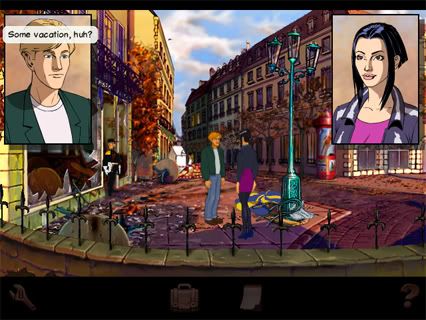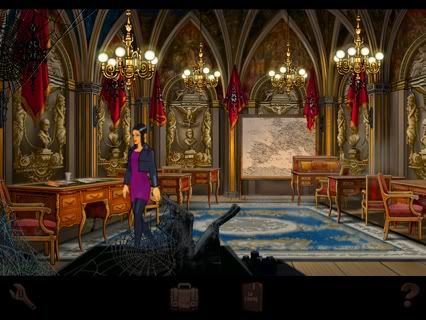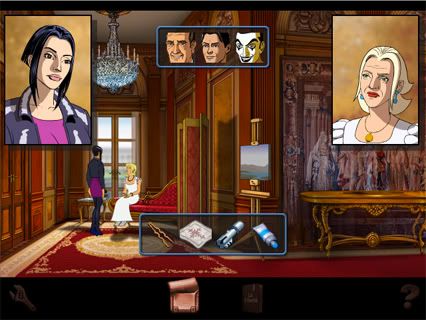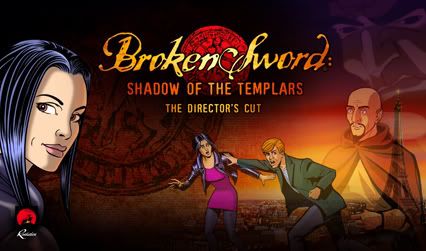- Format: PC (version reviewed), Mac, DS, Wii, iPad & iPhone
- Unleashed: Out Now
- Developer: Revolution Software
- Players: 1
- Site: revolution.co.uk
Broken Sword: Shadow of the Templars is considered one of the classics of 1990s PC adventure games. Re-released as a director’s cut though, the game doesn’t quite hold up, bouncing between being a charming point-and-click mystery and a relic of a genre that was too far up its own bum to hold relevance today.
The adventure game genre has experienced a bit of a renaissance, with Telltale Games getting most of the credit for their episodic comedy adventures like Sam & Max and Tales of Monkey Island. Then there’s the more experimental stuff; Indigo Prophecy (AKA Fahrenheit) and Heavy Rain both come off like evolutions of the genre, while games like Mass Effect and Alpha Protocol lace action-RPG combat with adventure game-style conversations. There’s even the occasional indie adventure, with games like Decay on Xbox Live Indie Games bringing back that atmospheric Myst vibe.
 But Broken Sword comes from a different time – one where adventure games were in high demand. People wanted challenging puzzles. They wanted something that would keep them busy for a while. The typical solution was to fill the games with puzzles that didn’t make a lick of sense.
But Broken Sword comes from a different time – one where adventure games were in high demand. People wanted challenging puzzles. They wanted something that would keep them busy for a while. The typical solution was to fill the games with puzzles that didn’t make a lick of sense.
Broken Sword doesn’t quite lose itself in the kind of nonsense that was attributed to the death of the genre, but it can still get pretty silly at times. Need to access an ancient shrine but can’t lift the statue that opens it? Simply drop it in the sand to make an impression, fill the impression with plaster, then go to a local bar and offer to fix their pump, wet a cloth in their sink basin, bring it back to the plaster, and pour it in to make a mold!
The worst part is that in context, that’s actually one of the more logical puzzles. The problem is that the game gets that lost in its own logic to begin with. The initial charm of Broken Sword is that it’s a game about normal people doing normal things in somewhat extraordinary circumstances, but it loses that as it goes on.
Set in Paris, the game has you playing as two characters, George Stobbart and Nico Collard, as they attempt to solve a murder mystery that unravels into a larger conspiracy. In the director’s cut release you begin the game as Nico, a freelance journalist on her way to meet a politician when he ends up being murdered.
 In terms of story, the director’s cut content is great. It develops Nico as a real character before George shows up and becomes the central hero. It’s almost hard to imagine the game without it. However, in terms of gameplay, even nearly 15 years later, the new content falls into old traps.
In terms of story, the director’s cut content is great. It develops Nico as a real character before George shows up and becomes the central hero. It’s almost hard to imagine the game without it. However, in terms of gameplay, even nearly 15 years later, the new content falls into old traps.
Nico’s prologue quickly ramps up in difficulty, making it embarrassingly easy to get stuck before the game even begins proper. Then, once you take control of George, the learning curve starts over again. The first challenging puzzles in the game don’t actually show up until much later, making the prologue seem out of place.
It’s a relief when you take control of George, as he spends a pretty long time simply talking to people and doing some light puzzle solving. As the ultimate good samaritan, he’s an interesting character – he’s simply an American tourist on holiday in Paris, until he too stumbles upon the scene of a murder.
Ultimately Broken Sword’s winning quality is that even after all this time, the setting and characters feel refreshing. You simply don’t get a lot of games set in modern-day Europe unless it’s alternate history and the place is infested with aliens. At the same time, it ends up being a double-edged sword. Without sci-fi stereotypes to rely on, the developers seemed to go for cultural stereotypes instead. When you arrive in Ireland and literally every single character is either in a bar, drunk, or trying to get drunk, it gets to be a bit offensive.
 As for the quality of the update, well, there hasn’t been much updating done. The graphics are smoothed out on higher resolution settings, and the new sections are sharper with cleaner audio; but visually the game hasn’t seen much change. This can be a bit disappointing in spots where the animation is sloppy or a cutscene is overly compressed.
As for the quality of the update, well, there hasn’t been much updating done. The graphics are smoothed out on higher resolution settings, and the new sections are sharper with cleaner audio; but visually the game hasn’t seen much change. This can be a bit disappointing in spots where the animation is sloppy or a cutscene is overly compressed.
One clever addition is a robust hint system. It alleviates some of the headaches caused by the obscure puzzle solutions, but also cheapens the experience if you use it too much. It’s smartly designed though, allowing you read one small hint at a time before finally just giving you the answer.
It’s clear to see why Broken Sword was enjoyable back in the day, but the game hasn’t aged so well. The additions for this director’s cut are a mixed bag, with the new story and hint system succeeding where the new puzzles fail. The game could have used a fresh coat of paint in terms of both graphics and gameplay. When you consider how many games are remade and brought into the modern era (including other adventure game releases), this director’s cut just seems like a lazy effort.
6/10



Comments